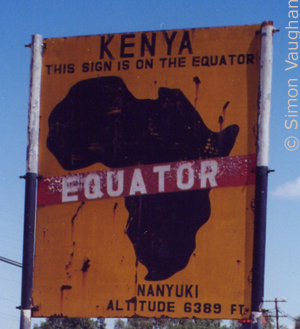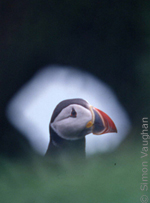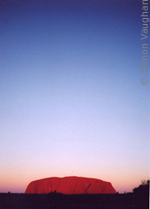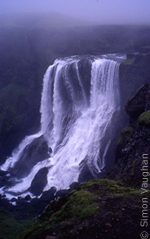 The first time I crossed the equator I was flying from London to Nairobi and it was early morning. The cabin crew was clearing away the breakfast trays and fellow passengers were gathering their things for our imminent arrival. I had opened the window blind and was gazing down at a rolling terrain of green hills and arid sun-scorched plains hoping for my first glimpse of African wildlife. ‘Was it possible to see an elephant from 20,000 feet?’ I wondered while surveying the sunrise that illuminated the not-so-dark Continent.
The first time I crossed the equator I was flying from London to Nairobi and it was early morning. The cabin crew was clearing away the breakfast trays and fellow passengers were gathering their things for our imminent arrival. I had opened the window blind and was gazing down at a rolling terrain of green hills and arid sun-scorched plains hoping for my first glimpse of African wildlife. ‘Was it possible to see an elephant from 20,000 feet?’ I wondered while surveying the sunrise that illuminated the not-so-dark Continent.
The First Officer announced that we had just passed the equator. Naturally, there was nothing to see or feel, but a murmur of excitement rippled through the cabin. We were in the southern hemisphere.
A few days later while driving to Kenya’s Northern Frontier
District, we crossed the equator for a second time, although on this occasion on the ground and there was something to see: a large roadside sign marking the invisible line that encircled the planet. We stopped the minivan and all bailed-out for the obligatory photograph…and science demonstration.
Everyone knows that in the northern hemisphere water flows down the drain in a clockwise direction whilst in the southern hemisphere it travels anti-clockwise. In my excitement and jet-lagged state I had forgotten to verify this phenomenon in my Nairobi hotel room, but now I had someone standing before me willing to provide a personal demonstration.
Anthony led me over to a bright yellow plastic jug filled with water and a large orange plastic bowl. He showed that the bowl had a small hole drilled in the bottom which he plugged with his finger tip, then bent over and filled it with water. He placed the jug upright on the ground, removed his finger from the hole and positioned the bowl on top of the jug. The water slowly drained into the jug beneath. Anthony took several small pieces of wood from his pocket – each no larger than a toothpick – and dropped them into the water. After a moment, the two sticks began to rotate anti-clockwise demonstrating that the water was flowing out of the bowl in that direction. With that, he fished out the sticks, picked up his equipment and led us 40 feet north into the northern hemisphere.
An equal distance from the sign, he repeated the experiment. Except this time, the little sticks rotated clockwise. Finally, we followed him back to the sign and directly beneath it, right smack-dab on the equator, he did it all a third time. Although the water was clearly flowing into the jug below, the sticks were only slightly oscillating, moving neither to the left nor right. It was an impressive display for which we happily paid Anthony a few dollars and received our commemorative equatorial science certificates.
Back in the van we continued our journey north through lush rolling hills not far from Africa’s second-highest peak, Mount Kenya. All but one of us had our certificates. The odd man out was sitting quietly by the window with a bemused smirk on his face. “You didn’t want the demonstration, David?” we asked curiously.
“It wasn’t true,” he explained. “How the water drains depends on how it was introduced into the bowl and on what forces have affected it since,” he continued. “This is true anywhere on earth, not just at the equator. The question seems to be based on the false, but often asserted, premise that the Earth’s rotation causes basins and toilets to drain clockwise in the northern hemisphere and anti-clockwise in the southern hemisphere. This is certainly true of cyclones and other large-scale weather phenomena, but the Coriolis force is so weak that it simply cannot affect a system as short lived as a basin full of water.”
With that, he turned back to the window while we folded up our certificates and placed them in our pockets…and no one spoke to David again for the rest of the trip. Next thing, the poor disillusioned young man would be telling us that Santa Claus didn’t exist.
Photo and post by: Simon Vaughan













